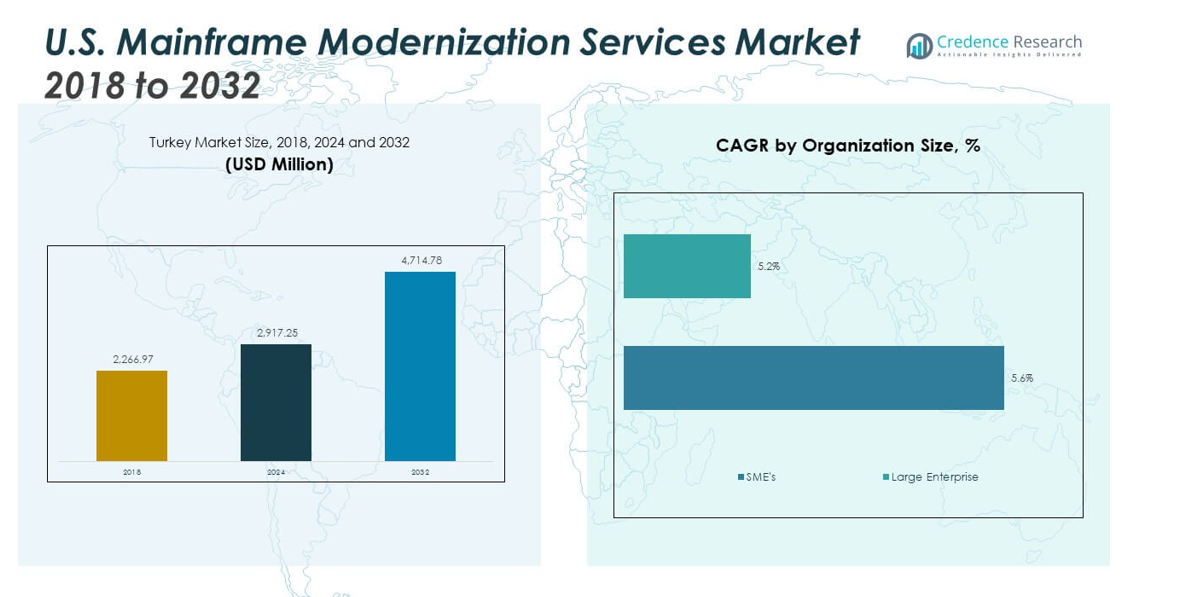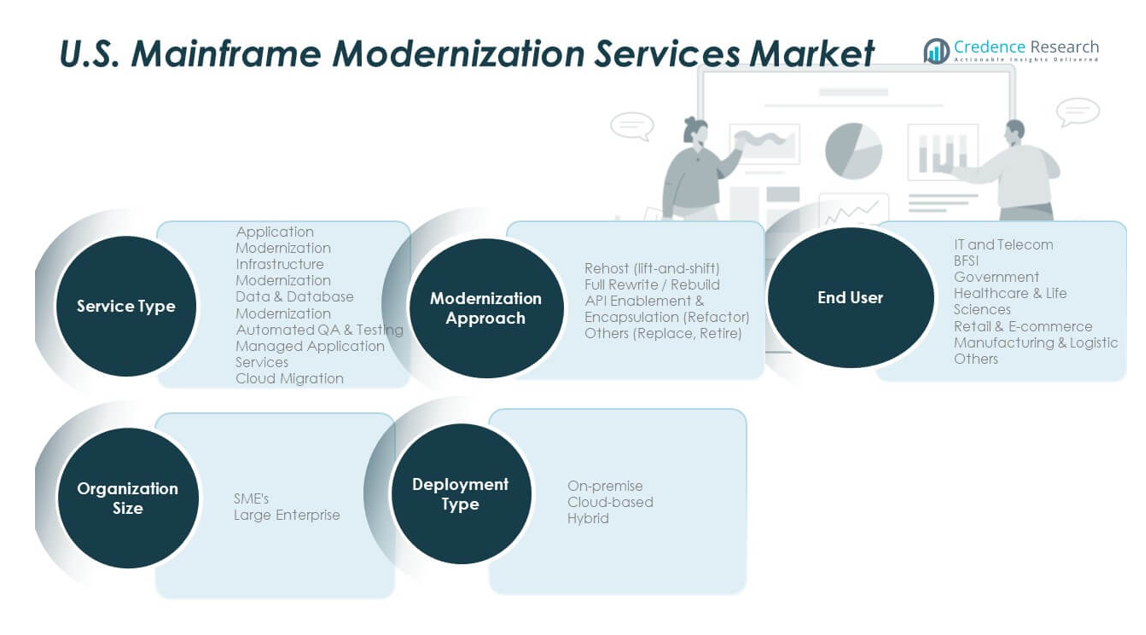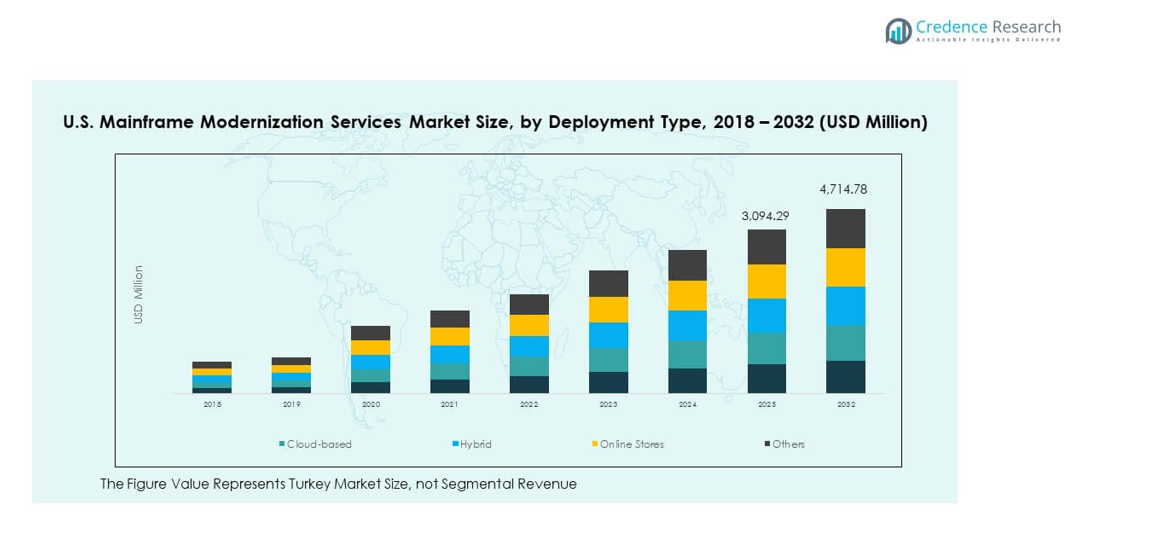CHAPTER NO. 1 : INTRODUCTION 21
1.1. Report Description 21
Purpose of the Report 21
USP & Key Offerings 21
1.2. Key Benefits for Stakeholders 22
1.3. Target Audience 22
CHAPTER NO. 2 : EXECUTIVE SUMMARY 23
CHAPTER NO. 3 : U.S. MAINFRAME MODERNIZATION SERVICES MARKET FORCES & INDUSTRY PULSE 25
3.1. Foundations of Change – Market Overview 25
3.2. Catalysts of Expansion – Key Market Drivers 27
3.3. Momentum Boosters – Growth Triggers 28
3.4. Innovation Fuel – Disruptive Technologies 28
3.5. Headwinds & Crosswinds – Market Restraints 29
3.6. Regulatory Tides – Compliance Challenges 30
3.7. Economic Frictions – Inflationary Pressures 30
3.8. Untapped Horizons – Growth Potential & Opportunities and Strategic Navigation – Industry Frameworks 31
3.9. Market Equilibrium – Porter’s Five Forces 32
3.10. Macro Forces – PESTEL Breakdown 34
CHAPTER NO. 4 : COMPETITION ANALYSIS 36
4.1. Company Market Share Analysis 36
4.1.1. U.S. Mainframe Modernization Services Market Company Revenue Market Share 36
4.2. Strategic Developments 38
4.2.1. Acquisitions & Mergers 38
4.2.2. New Service Type Launch 39
4.2.3. Agreements & Collaborations 40
4.3. Competitive Dashboard 41
4.4. Company Assessment Metrics, 2024 42
CHAPTER NO. 5 : U.S. MARKET ANALYSIS, INSIGHTS & FORECAST, BY SERVICE TYPE 43
CHAPTER NO. 6 : U.S. MARKET ANALYSIS, INSIGHTS & FORECAST, BY MODERNIZATION APPROACH 48
CHAPTER NO. 7 : U.S. MARKET ANALYSIS, INSIGHTS & FORECAST, BY END-USER 52
CHAPTER NO. 8 : U.S. MARKET ANALYSIS, INSIGHTS & FORECAST, BY ORGANIZATION SIZE 57
CHAPTER NO. 9 : U.S. MARKET ANALYSIS, INSIGHTS & FORECAST, BY DEPLOYMENT TYPE 61
CHAPTER NO. 10 : COMPANY PROFILE 65
10.1. IBM 65
10.2. Infosys 68
10.3. TCS 68
10.4. Cognizant 68
10.5. Accenture 68
10.6. HCL Technologies 68
10.7. DXC Technology 68
10.8. Wipro 68
10.9. Capgemini 68
10.10. NTT DATA Services 68
10.11. Company 11 68
10.12. Company 12 68
10.13. Company 13 68
10.14. Company 14 68
List of Figures
FIG NO. 1. U.S. Mainframe Modernization Services Market Revenue Share, By Service Type, 2024 & 2032 43
FIG NO. 2. Market Attractiveness Analysis, By Service Type 44
FIG NO. 3. Incremental Revenue Growth Opportunity by Service Type, 2024 – 2032 45
FIG NO. 4. U.S. Mainframe Modernization Services Market Revenue Share, By Modernization Approach, 2024 & 2032 48
FIG NO. 5. Market Attractiveness Analysis, By Modernization Approach 49
FIG NO. 6. Incremental Revenue Growth Opportunity by Modernization Approach, 2024 – 2032 50
FIG NO. 7. U.S. Mainframe Modernization Services Market Revenue Share, By End-user, 2024 & 2032 52
FIG NO. 8. Market Attractiveness Analysis, By End-user 53
FIG NO. 9. Incremental Revenue Growth Opportunity by End-user, 2024 – 2032 54
FIG NO. 10. U.S. Mainframe Modernization Services Market Revenue Share, By Organization Size, 2024 & 2032 57
FIG NO. 11. Market Attractiveness Analysis, By Organization Size 58
FIG NO. 12. Incremental Revenue Growth Opportunity by Organization Size, 2024 – 2032 59
FIG NO. 13. U.S. Mainframe Modernization Services Market Revenue Share, By Deployment Type, 2024 & 2032 61
FIG NO. 14. Market Attractiveness Analysis, By Deployment Type 62
FIG NO. 15. Incremental Revenue Growth Opportunity by Deployment Type, 2024 – 2032 63
List of Tables
TABLE NO. 1. : U.S. Mainframe Modernization Services Market Revenue, By Service Type, 2018 – 2024 (USD Million) 46
TABLE NO. 2. : U.S. Mainframe Modernization Services Market Revenue, By Service Type, 2025 – 2032 (USD Million) 47
TABLE NO. 3. : U.S. Mainframe Modernization Services Market Revenue, By Modernization Approach, 2018 – 2024 (USD Million) 51
TABLE NO. 4. : U.S. Mainframe Modernization Services Market Revenue, By Modernization Approach, 2025 – 2032 (USD Million) 51
TABLE NO. 5. : U.S. Mainframe Modernization Services Market Revenue, By End-user, 2018 – 2024 (USD Million) 55
TABLE NO. 6. : U.S. Mainframe Modernization Services Market Revenue, By End-user, 2025 – 2032 (USD Million) 56
TABLE NO. 7. : U.S. Mainframe Modernization Services Market Revenue, By Organization Size, 2018 – 2024 (USD Million) 60
TABLE NO. 8. : U.S. Mainframe Modernization Services Market Revenue, By Organization Size, 2025 – 2032 (USD Million) 60
TABLE NO. 9. : U.S. Mainframe Modernization Services Market Revenue, By Deployment Type, 2018 – 2024 (USD Million) 64
TABLE NO. 10. : U.S. Mainframe Modernization Services Market Revenue, By Deployment Type, 2025 – 2032 (USD Million) 64






